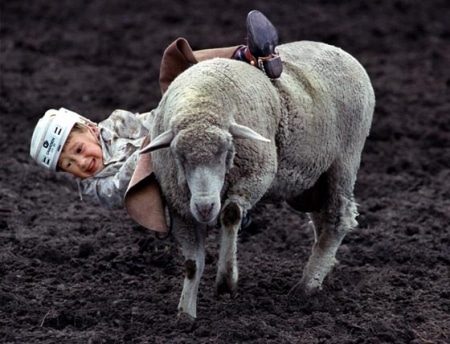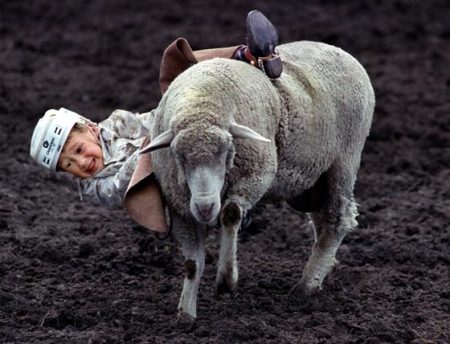

Kids and animals get rights trampled at rodeos
Usually I write about animal abuse. But today’s story packs a double whammy.
It’s about a popular rodeo sideshow that doesn’t just harm animals. Children suffer too.
I first heard about this dangerous rite of passage known as "mutton
busting" while watching a recorded episode of the Today Show at the end
of March. At the time, I was so shocked by the event that I rewound the
news story several times to watch the video footage over and over.
I couldn’t believe what I was seeing. And even worse, I was stunned by
the way the story was being presented. The jovial tone of the reporter
who did the voice-over. And the hosts’ reactions when the story ended
and the spotlight was thrown back to them.
Matt Lauer and Meredith Vieira grinned to each other and the audience,
seemingly marveling at the cuteness of it all. Then Vieira made a joke.
She laughed that "the kids weren’t half b-a-a-a-d" out there riding the sheep.
I wonder if she would find it so funny if she knew what rodeos are
really about. Not just for the animals forced to participate in the
abusive events in general, but also for the pint-sized participants
coerced into entering this contest in particular.
Children from four to six years old are encouraged, goaded, sometimes
even downright shamed by their parents into participating. Before and
during their woolly ride on a sheep, fear is evident on the kids’
faces. And they aren’t the only ones who are distressed. The sheep who
are forced to be ridden are clearly frightened. They writhe and buck
violently in an attempt to throw the tiny trespassers off.
Injuries sustained by children who enter the mutton busting contests
are varied and significant. Fractures of the arms and legs. Head, neck
and spinal cord injuries. Children might be dragged by the animal if a
foot gets caught in a stirrup. They can be thrown to the ground and
trampled once they land.
Still, it’s virtually a picnic for the kids who go to the rodeo compared
to what happens to the animals. After they have been killed, or maimed
past their usefulness, rodeo animals are sold for meat. That is where
the veterinarians who work for the U.S. Department of Agriculture have
witnessed the extent of the cruelty inflicted on them.
The animals who come from rodeos are characterized by "broken ribs,
punctured lungs, hematomas, broken legs and severed tracheas," says Dr.
Robert Fetzner, Director of Slaughter Operations for Food Safety and
Inspection Service for the U.S. Department of Agriculture (USDA).
Veterinarian C.G. Haber, a USDA career inspector with 30 years on the job, has similar horror stories to tell.
"The rodeo folks send their animals to the packing houses where…I
have seen cattle so extensively bruised that the only areas in which
the skin was attached was the head, neck, legs and belly," says Dr.
Haber. "I have seen animals with six to eight ribs broken from the
spine and at times puncturing the lungs. I have seen as much as two and
three gallons of free blood accumulated under the detached skin."
Still not convinced that riding sheep isn’t a child-friendly activity?
Then check out some videos of kids mutton busting on the website for Shark, an anti-rodeo animal welfare group.
Here’s the dirt on rodeos
The true extent of animal suffering that is endured at rodeos is generally hidden from public view. But animal advocates working undercover have managed to get video and photographs. If you care to research further, this evidence can be widely viewed on the Internet. Be forewarned — the images you will encounter are disturbing.
Calf roping: Three- and four-month old calves are put in a chute, tortured with electric shock prods, and "clotheslined" around the neck as they race out of the gate in panic at breakneck speeds. If repeatedly shocking them in holding chutes doesn’t get them moving, their tails might be wrenched over steel bars. Thinking they have escaped the torture, they charge into the ring area, where the cowboy’s rigorous neck-choke hoists them into the air before they hit hard ground. As they wheeze and tremble, the contestant might body-slam them again.
Steer tipping: Handlers rope the steers’ horns, and when the galloping horse turns, the steer’s head and neck are jerked 180 degrees in a quick movement by the handler, causing the animal to be violently tripped, rolled and dragged for 30 feet. The stress to the neck is enormous. Sometimes the horns are fractured. The object of the game is to take the steer down violently enough to stun it. Eventually their broken bodies are useless for this event, and they are sold to slaughterhouses.
Bull riding: The bulls are shocked repeatedly with cattle prods to start them bucking helplessly in the chute. Shock prod use is common, as 5,000 volts of electrified pain is shot into an animal’s flesh for entertainment purposes. The bucking straps and spurs can cause the bull to buck beyond his capability. The legs or back can be broken. Flank straps are secured around the animal’s abdomen and groin, causing internal bleeding and sores, to increase the bucking motion as the animal desperately tries to flee its predicament.
Bronc riding (saddle and bareback): This activity claims the lives of many horses. The horses crash blindly in panic in the chutes, or run into posts in the holding fence. Bucking horses must be spurred over the shoulders on each jump or buck for the rider to qualify. The spurs cause blunt trauma to the animal’s shoulders. That doesn’t heal before the activity starts all over again.
Practice pens: Life is no kinder for the calves sold to the practice pens for this event. Calf roping, a timed competition, requires much practice, and these animals are roped over and over until they are injured or killed.
Click Carreen’s Rescue Blog to return to the main page.
Carreen Maloney can be reached at carreen@fuzzytown.com.
Join the newsletter and never miss out on dog content again!
"*" indicates required fields
By clicking the arrow, you agree to our web Terms of Use and Privacy & Cookie Policy. Easy unsubscribe links are provided in every email.